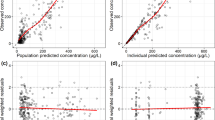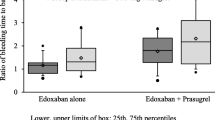Abstract
Apixaban is used in the prevention and treatment of patients with deep vein thrombosis or pulmonary embolism, and in the prevention of stroke or systemic embolism in patients with nonvalvular atrial fibrillation (AF). In this study, we aimed to elucidate intrinsic factors affecting efficacy of apixaban by conducting population pharmacokinetic and pharmacodynamic analysis using data from 81 Japanese AF patients. The intrinsic FXa activity was determined to assess the pharmacodynamic effect of apixaban. The pharmacokinetic and pharmacodynamic profiles were described based on a one-compartment model with first-order absorption and a maximum inhibitory model, respectively. Pharmacokinetic and pharmacodynamic analysis was conducted using a nonlinear mixed effect modeling program. The population pharmacokinetic parameters of apixaban were fixed at the reported values in our recent study. The population mean of half-maximal inhibitory concentration (IC50) of apixaban was estimated to be 45.3 ng/mL. The population mean IC50 decreased 27.7% for patients with heart failure, but increased 55% for patients with a medical history of cerebral infarction. In contrast, no covariates affected the population mean of baseline of intrinsic FXa activity (BASE) and maximum effect (Imax) value of apixaban. The population mean of BASE and Imax value were estimated to be 40.2 and 38.4 nmol/min/mg protein, respectively. The present study demonstrates for the first time that the co-morbidity of heart failure as well as the medical history of cerebral infarction are an intrinsic factor affecting the pharmacodynamics of apixaban.



Similar content being viewed by others
References
Pinto DJ, Orwat MJ, Koch S, Rossi KA, Alexander RS, Smallwood A, et al. 1-(4-Methoxyphenyl)-7-oxo-6-(4-(2-oxopiperidin-1-yl)phenyl)-4,5,6,7-tetrahydro-1H-pyrazolo[3,4-c]pyridine-3-carboxamide (apixaban, BMS-562247), a highly potent, selective, efficacious, and orally bioavailable inhibitor of blood coagulation factor Xa. J Med Chem. 2007;50:5339–56. https://doi.org/10.1021/jm070245n.
Lassen MR, Raskob GE, Gallus A, Pineo G, Chen D, Hornick P. Apixaban versus enoxaparin for thromboprophylaxis after knee replacement (ADVANCE-2): a randomised double-blind trial. Lancet. 2010;375:807–15. https://doi.org/10.1016/S0140-6736(09)62125-5.
Lassen MR, Gallus A, Raskob GE, Pineo G, Chen D, Ramirez LM. Apixaban versus enoxaparin for thromboprophylaxis after hip replacement. N Engl J Med. 2010;363:2487–98. https://doi.org/10.1056/NEJMoa1006885.
Agnelli G, Buller HR, Cohen A, Curto M, Gallus AS, Johnson M, et al. Apixaban for extended treatment of venous thromboembolism. N Engl J Med. 2013;368:699–708. https://doi.org/10.1056/NEJMoa1207541.
Agnelli G, Buller HR, Cohen A, Curto M, Gallus AS, Johnson M, et al. Oral apixaban for the treatment of acute venous thromboembolism. N Engl J Med. 2013;369:799–808. https://doi.org/10.1056/NEJMoa1302507.
Connolly SJ, Eikelboom J, Joyner C, Diener HC, Hart R, Golitsyn S, et al. Apixaban in patients with atrial fibrillation. N Engl J Med. 2011;364:806–17. https://doi.org/10.1056/NEJMoa1007432.
Granger CB, Alexander JH, McMurray JJ, Lopes RD, Hylek EM, Hanna M, et al. Apixaban versus warfarin in patients with atrial fibrillation. N Engl J Med. 2011;365:981–92. https://doi.org/10.1056/NEJMoa1107039.
Ogawa S, Shinohara Y, Kanmuri K. Safety and efficacy of the oral direct factor xa inhibitor apixaban in Japanese patients with non-valvular atrial fibrillation. The ARISTOTLE-J study. Circ J. 2011;75:1852–9. https://doi.org/10.1253/circj.CJ-10-1183.
Jaspers Focks J, Brouwer MA, Wojdyla DM, Thomas L, Lopes RD, Washam JB, et al. Polypharmacy and effects of apixaban versus warfarin in patients with atrial fibrillation: post hoc analysis of the ARISTOTLE trial. BMJ. 2016;353:i2868. https://doi.org/10.1136/bmj.i2868.
Ruiz Ortiz M, Muñiz J, Raña Míguez P, Roldán I, Marín F, Asunción Esteve-Pastor M, et al. Inappropriate doses of direct oral anticoagulants in real-world clinical practice: prevalence and associated factors. A subanalysis of the FANTASIIA registry. Europace. 2018;20:1577–83. https://doi.org/10.1093/europace/eux316.
Wang L, Zhang D, Raghavan N, Yao M, Ma L, Frost CE, et al. In vitro assessment of metabolic drug-drug interaction potential of apixaban through cytochrome P450 phenotyping, inhibition, and induction studies. Drug Metab Dispos. 2010;38:448–58. https://doi.org/10.1124/dmd.109.029694.
Gong IY, Kim RB. Importance of pharmacokinetic profile and variability as determinants of dose and response to dabigatran, rivaroxaban, and apixaban. Can J Cardiol. 2013;29:S24–33. https://doi.org/10.1016/j.cjca.2013.04.002.
Zhang D, He K, Herbst JJ, Kolb J, Shou W, Wang L, et al. Characterization of efflux transporters involved in distribution and disposition of apixaban. Drug Metab Dispos. 2013;41:827–35. https://doi.org/10.1124/dmd.112.050260.
Leil TA, Feng Y, Zhang L, Paccaly A, Mohan P, Pfister M. Quantification of apixaban’s therapeutic utility in prevention of venous thromboembolism: selection of phase III trial dose. Clin Pharmacol Ther. 2010;88:375–82. https://doi.org/10.1038/clpt.2010.106.
Leil TA, Frost C, Wang X, Pfister M, LaCreta F. Model-based exposure-response analysis of apixaban to quantify bleeding risk in special populations of subjects undergoing orthopedic surgery. CPT Pharmacometrics Syst Pharmacol. 2014;3:e136. https://doi.org/10.1038/psp.2014.34.
Byon W, Sweeney K, Frost C, Boyd RA. Population pharmacokinetics, pharmacodynamics, and exploratory exposure-response analyses of apixaban in subjects treated for venous thromboembolism. CPT Pharmacometrics Syst Pharmacol. 2017;6:340–9. https://doi.org/10.1002/psp4.12184.
Cirincione B, Kowalski K, Nielsen J, Roy A, Thanneer N, Byon W, et al. Population pharmacokinetics of apixaban in subjects with nonvalvular atrial fibrillation. CPT Pharmacometrics Syst Pharmacol. 2018;7:728–38. https://doi.org/10.1002/psp4.12347.
Ueshima S, Hira D, Kimura Y, Fujii R, Tomitsuka C, Yamane T, et al. Population pharmacokinetics and pharmacogenomics of apixaban in Japanese adult patients with atrial fibrillation. Br J Clin Pharmacol. 2018;84:1301–12. https://doi.org/10.1111/bcp.13561.
Frost C, Wang J, Nepal S, Schuster A, Barrett YC, Mosqueda-Garcia R, et al. Apixaban, an oral, direct factor Xa inhibitor: single dose safety, pharmacokinetics, pharmacodynamics and food effect in healthy subjects. Br J Clin Pharmacol. 2013;75:476–87. https://doi.org/10.1111/j.1365-2125.2012.04369.x.
Frost C, Nepal S, Wang J, Schuster A, Byon W, Boyd RA, et al. Safety, pharmacokinetics and pharmacodynamics of multiple oral doses of apixaban, a factor Xa inhibitor, in healthy subjects. Br J Clin Pharmacol. 2013;76:776–86. https://doi.org/10.1111/bcp.12106.
Yamahira N, Frost C, Fukase H, Yu Z, Wang J, Pursley J, et al. Safety, tolerability, pharmacokinetics, and pharmacodynamics of multiple doses of apixaban in healthy Japanese male subjects. Int J Clin Pharmacol Ther. 2014;52:564–73. https://doi.org/10.5414/CP201967.
Upreti VV, Wang J, Barrett YC, Byon W, Boyd RA, Pursley J, et al. Effect of extremes of body weight on the pharmacokinetics, pharmacodynamics, safety and tolerability of apixaban in healthy subjects. Br J Clin Pharmacol. 2013;76:908–16. https://doi.org/10.1111/bcp.12114.
Frost C, Shenker A, Gandhi MD, Pursley J, Barrett YC, Wang J, et al. Evaluation of the effect of naproxen on the pharmacokinetics and pharmacodynamics of apixaban. Br J Clin Pharmacol. 2014;78:877–85. https://doi.org/10.1111/bcp.12393.
Tanigawa T, Kaneko M, Hashizume K, Kajikawa M, Ueda H, Tajiri M, et al. Model-based dose selection for phase III rivaroxaban study in Japanese patients with non-valvular atrial fibrillation. Drug Metab Pharmacokinet. 2013;28:59–70. https://doi.org/10.2133/dmpk.DMPK-12-RG-034.
Song S, Kang D, Halim AB, Miller R. Population pharmacokinetic-pharmacodynamic modeling analysis of intrinsic FXa and bleeding from edoxaban treatment. J Clin Pharmacol. 2014;54:910–6. https://doi.org/10.1002/jcph.306.
Cockcroft DW, Gault MH. Prediction of creatinine clearance from serum creatinine. Nephron. 1976;16:31–41. https://doi.org/10.1159/000180580.
Ueshima S, Hira D, Fujii R, Kimura Y, Tomitsuka C, Yamane T, et al. Impact of ABCB1, ABCG2, and CYP3A5 polymorphisms on plasma trough concentrations of apixaban in Japanese patients with atrial fibrillation. Pharmacogenet Genomics. 2017;27:329–36. https://doi.org/10.1097/FPC.0000000000000294.
Kubitza D, Becka M, Voith B, Zuehlsdorf M, Wensing G. Safety, pharmacodynamics, and pharmacokinetics of single doses of BAY 59-7939, an oral, direct factor Xa inhibitor. Clin Pharmacol Ther. 2005;78:412–21. https://doi.org/10.1016/j.clpt.2005.06.011.
Bradford MM. A rapid and sensitive method for the quantification of microgram quantities of protein utilizing the principle of protein-dye binding. Anal Biochem. 1976;72:248–54. https://doi.org/10.1016/0003-2697(76)90527-3.
Zhang L, Beal SL, Sheiner LB. Simultaneous vs. sequential analysis for population PK/PD data I: best-case performance. J Pharmacokinet Pharmacodyn. 2003;30:387–404. https://doi.org/10.1023/B:JOPA.0000012998.04442.1f.
Zhang L, Beal SL, Sheiner LB. Simultaneous vs. sequential analysis for population PK/PD data II: robustness of methods. J Pharmacokinet Pharmacodyn. 2003;30:405–16. https://doi.org/10.1023/B:JOPA.0000012999.36063.4e.
Lindbom L, Pihlgren P, Jonsson EN. PsN-Toolkit—a collection of computer intensive statistical methods for non-linear mixed effect modeling using NONMEM. Comput Methods Prog Biomed. 2005;79:241–57. https://doi.org/10.1016/j.cmpb.2005.04.005.
Stroke Prevention in Atrial Fibrillation Investigators. Adjusted-dose warfarin versus low-intensity, fixed-dose warfarin plus aspirin for high-risk patients with atrial fibrillation: Stroke Prevention in Atrial Fibrillation III randomised clinical trial. Lancet. 1996;348:633–8. https://doi.org/10.1016/S0140-6736(96)03487-3.
Yang ZJ, Sheth SH, Smith CH, Schmotzer AR, Lippello AL, Al-Khafaji A, et al. Plasma from chronic liver disease subjects exhibit differential ability to generate thrombin. Blood Coagul Fibrinolysis. 2015;26:844–7. https://doi.org/10.1097/MBC.0000000000000365.
Adams MJ, Irish AB, Watts GF, Oostryck R, Dogra GK. Hypercoagulability in chronic kidney disease is associated with coagulation activation but not endothelial function. Thromb Res. 2008;123:374–80. https://doi.org/10.1016/j.thromres.2008.03.024.
Tripodi A, Mannucci PM. The coagulopathy of chronic liver disease. N Engl J Med. 2011;365:147–56. https://doi.org/10.1056/NEJMra1011170.
Bauer KA, Weiss LM, Sparrow D, Vokonas PS, Rosenberg RD. Aging-associated changes in indices of thrombin generation and protein C activation in humans. Normative Aging Study. J Clin Invest. 1987;80:1527–34. https://doi.org/10.1172/JCI113238.
Robles-Diaz M, Lucena MI, Kaplowitz N, Stephens C, Medina-Cáliz I, González-Jimenez A, et al. Use of Hy’s law and a new composite algorithm to predict acute liver failure in patients with drug-induced liver injury. Gastroenterology. 2014;147:109–18. https://doi.org/10.1053/j.gastro.2014.03.050.
Gage BF, Waterman AD, Shannon W, Boechler M, Rich MW, Radford MJ. Validation of clinical classification schemes for predicting stroke: results from the National Registry of Atrial Fibrillation. JAMA. 2001;285:2864–70. https://doi.org/10.1001/jama.285.22.2864.
Rapaport SI, Rao LV. The tissue factor pathway: how it has become a “prima ballerina”. Thromb Haemost. 1995;74:7–17. https://doi.org/10.1055/s-0038-1642646.
Brummel-Ziedins KE, Lam PH, Gissel M, Gauthier E, Schneider DJ. Depletion of systemic concentrations of coagulation factors in blood from patients with atherosclerotic vascular disease. Coron Artery Dis. 2013;24:468–74. https://doi.org/10.1097/MCA.0b013e3283632575.
He M, Wen Z, He X, Xiong S, Liu F, Xu J, et al. Observation on tissue factor pathway and some other coagulation parameters during the onset of acute cerebrocardiac thrombotic diseases. Thromb Res. 2002;107:223–8. https://doi.org/10.1016/S0049-3848(02)00331-6.
Lagishetty CV, Duffull SB. Evaluation of approaches to deal with low-frequency nuisance covariates in population pharmacokinetic analyses. AAPS J. 2015;17:1388–94. https://doi.org/10.1208/s12248-015-9793-x.
Funding
This study was supported in part by JSPS KAKENHI Grant Number 15K18938, the Japan Research Foundation for Clinical Pharmacology, and the Uehara Memorial Foundation.
Author information
Authors and Affiliations
Corresponding author
Ethics declarations
Conflict of Interest
The authors declare that they have no conflict of interest.
Additional information
Publisher’s Note
Springer Nature remains neutral with regard to jurisdictional claims in published maps and institutional affiliations.
Rights and permissions
About this article
Cite this article
Ueshima, S., Hira, D., Tomitsuka, C. et al. Population Pharmacokinetics and Pharmacodynamics of Apixaban Linking Its Plasma Concentration to Intrinsic Activated Coagulation Factor X Activity in Japanese Patients with Atrial Fibrillation. AAPS J 21, 80 (2019). https://doi.org/10.1208/s12248-019-0353-7
Received:
Accepted:
Published:
DOI: https://doi.org/10.1208/s12248-019-0353-7




